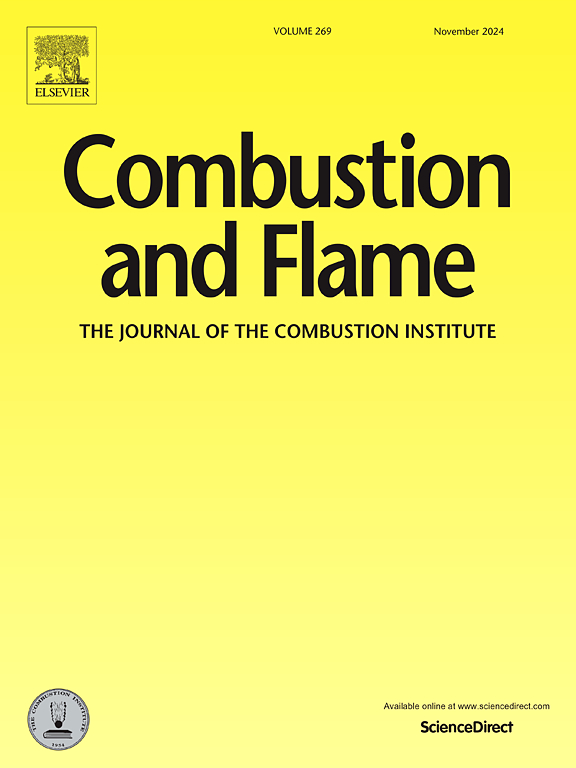A general formalism for determining the unburnt composition in multi-stream species transport-based CFD simulations
IF 5.8
2区 工程技术
Q2 ENERGY & FUELS
引用次数: 0
Abstract
The imperative to decarbonise combustion necessitates technical solutions that increasingly rely on the concurrent utilisation of different fuels and/or oxidisers. The complexity of the reactive mixture compositions in such scenarios poses additional challenges from a CFD modelling perspective. While species transport models can generally describe multi-stream combustion problems directly, the definition of turbulence-chemistry interaction closures or the proper comprehension of combustion regimes often requires the reconstruction of the non-reactive mixing field. This work proposes a general comprehensive formalism for determining the unburnt composition in multi-stream combustion environments. The method relies on the elemental mass fraction conservation for the definition of a linear system that can be solved at runtime to retrieve the local unburnt mixture composition. The introduced formalism allows to assess the number of auxiliary stream-tracking scalars , thereby minimising computational efforts and effectively enabling the use of the inherent information within the set of transported species. The study presents an application example where a dual-fuel turbulent combustion scenario is numerically investigated. In this context, the consistency of the method with respect to the use of passive scalars has been discussed with and without the species equi-diffusivity assumption. A procedure for the estimation of the error introduced by the species preferential diffusion has been proposed, providing insights about the expected uncertainty on the predicted mixture composition and the respective flame properties.
Novelty and Significance Statement
The determination of the non-reactive mixing field is crucial for understanding reactive CFD simulations based on species transport. Additionally, in turbulent combustion models, knowing the unburnt composition is often a pivotal requirement for the model closure. While recalculated mixture fractions can determine the unburnt composition in dual-stream problems, this approach is inappropriate for multi-stream problems. This research introduces a novel generalised method for determining unburnt mixture composition in multi-stream combustion scenarios using CFD calculations based on species transport. The proposed method minimises the need for additional passive scalars by efficiently utilising existing information from the solved equations and boundary conditions, leveraging elemental mass fraction conservation.
基于多流种输运的CFD模拟中确定未燃成分的一般形式
脱碳燃烧势在必行,需要越来越依赖于同时使用不同燃料和/或氧化剂的技术解决方案。在这种情况下,反应性混合物组成的复杂性从CFD建模的角度提出了额外的挑战。虽然物质输运模型通常可以直接描述多流燃烧问题,但湍流-化学相互作用闭包的定义或对燃烧形式的正确理解往往需要重建非反应性混合场。这项工作提出了一个通用的综合形式,以确定在多流燃烧环境中未燃烧成分。该方法依靠元素质量分数守恒来定义一个线性系统,该系统可以在运行时求解以检索局部未燃烧混合物的组成。引入的形式允许先验地评估辅助流跟踪标量的数量,从而最大限度地减少计算工作量,并有效地利用运输物种集合中的固有信息。本文给出了双燃料湍流燃烧的数值模拟应用实例。在此背景下,讨论了在有无种等扩散率假设的情况下,该方法与使用被动标量的一致性。提出了一种先验估计由物种优先扩散引入的误差的方法,提供了对预测混合物成分和各自火焰特性的预期不确定性的见解。新颖性和意义声明非反应性混合场的确定对于理解基于物质输运的反应性CFD模拟至关重要。此外,在湍流燃烧模型中,了解未燃烧成分通常是模型关闭的关键要求。虽然重新计算的混合物分数可以确定双流问题中的未燃烧成分,但这种方法不适用于多流问题。本研究介绍了一种新的通用方法,用于确定多流燃烧场景中基于物质输运的CFD计算的未燃烧混合物成分。所提出的方法通过有效地利用已解方程和边界条件中的现有信息,利用元素质量分数守恒,最大限度地减少了对额外被动标量的需求。
本文章由计算机程序翻译,如有差异,请以英文原文为准。
求助全文
约1分钟内获得全文
求助全文
来源期刊

Combustion and Flame
工程技术-工程:化工
CiteScore
9.50
自引率
20.50%
发文量
631
审稿时长
3.8 months
期刊介绍:
The mission of the journal is to publish high quality work from experimental, theoretical, and computational investigations on the fundamentals of combustion phenomena and closely allied matters. While submissions in all pertinent areas are welcomed, past and recent focus of the journal has been on:
Development and validation of reaction kinetics, reduction of reaction mechanisms and modeling of combustion systems, including:
Conventional, alternative and surrogate fuels;
Pollutants;
Particulate and aerosol formation and abatement;
Heterogeneous processes.
Experimental, theoretical, and computational studies of laminar and turbulent combustion phenomena, including:
Premixed and non-premixed flames;
Ignition and extinction phenomena;
Flame propagation;
Flame structure;
Instabilities and swirl;
Flame spread;
Multi-phase reactants.
Advances in diagnostic and computational methods in combustion, including:
Measurement and simulation of scalar and vector properties;
Novel techniques;
State-of-the art applications.
Fundamental investigations of combustion technologies and systems, including:
Internal combustion engines;
Gas turbines;
Small- and large-scale stationary combustion and power generation;
Catalytic combustion;
Combustion synthesis;
Combustion under extreme conditions;
New concepts.
 求助内容:
求助内容: 应助结果提醒方式:
应助结果提醒方式:


